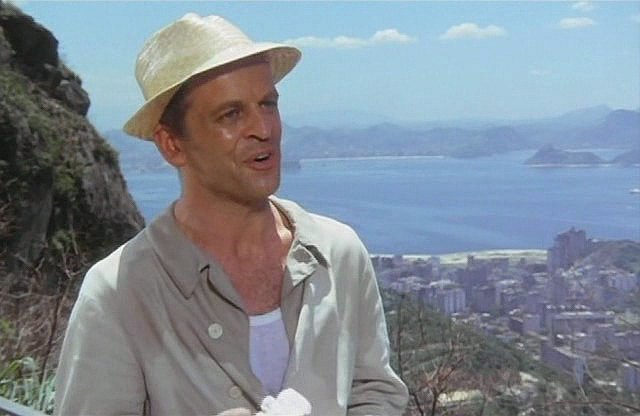Dir: Albert Cardiff, Robert Lynn and Sheldon Reynolds
Stsr: Stewart Granger, Pierre Brice, Lex Barker, Klaus Kinski
a.k.a. Gern hab’ ich die Frauen gekillt, Spies Against the World
I think there’s a good reason the anthology film is more common in genres like horror than the spy field. While you can conjure up scares with a relatively scant amount of storyline, it takes a fair amount of plotting to put together a decent espionage yarn. That certainly seems to be the case here, where the three stories presented are all underdeveloped, little more than trifles where any potential interest is only sketched out in the briefest of terms. It’s like this film is an artist’s impression of three statues, rather than any of them being fully-fledged work in themselves. The wraparound story is also rather dumb. A wanted man (Peter Vogel) takes refuge in the house of a professor (Patton‘s Richard Münch); while waiting for the police who are combing the era to leave, the professor tells three stories of crime and espionage, with the vague moral that crime doesn’t pay. [The way this ends, after the final tale is told, likely will be among the more WTF? twists you’ll have seen]
The first story takes place in Vienna, and is clearly trying to channel The Third Man, right down to the zither-laden soundtrack. After a woman’s journalist brother is killed in a car “accident”, she goes to David Porter (Granger), a grumpy private-eye who initially refuses to help, but eventually agrees after seeing that the woman was apparently trailed to his office. The journalist had been investigating a drugs ring, travelling across Europe to find its leader, and it seems he may have got too close to the truth. Porter pays a visit to the last person shown in the dead writer’s journal before his untimely demise, and discovers that the conclusion that contact was a dead-end is not entirely true. So why would a journalist lie in his own notes to himself? It;s an intriguing idea, but no sooner has it been set up, than it’s resolved, in about two minutes of unconvincing deductive work, because the film needs to gallop on to the second installment.
This is more of a spy caper, and is clearly not intended to be taken seriously, right from the time that the hero, Agent Brice (Brice) gets his instructions in the form of a 7″ single made of spaghetti, which he is instructed to eat after listening to. Though disappointingly, he doesn’t bother to boil the pasta record and serve with a nice carbonara sauce. What a Philistine. His mission, should he choose to accept it, is delivering a package of documents to a specific location, but Brice soon finds the Chico gang are also after the papers, and will stop at nothing to get their hands on them. With no backup to hand, he has to figure out who he can trust, and who is really working for the enemy. If light-hearted in nature, that’s no excuse for being dull as ditch-water, with comic mugging and slapstick replacing anything likely to cause more than a slight twitch at the corner of your mouth.
The third is perhaps the most interesting, and has the most potential for development, though as with the other two, is severely hampered by having to gallop through the narrative at such a pace as to leave little or no room for character portrayal, atmosphere, etc. It starts in San Francisco with the discovery of two dead women in the ocean; private eye Glenn Cassidy (Barker) investigates, and discovers that they were killed to try and hush up a planned plot to assassinate the Brazilian president during the Rio carnival. He takes the place of the assassin hired for the job, and heads for Brazil to expose the ringleader, who is incredibly cautious with regard to protecting his identity, to the extent of wearing a black hood when he meets with Cassidy. This has some nice action sequences, in particular a roof-top chase involving a Ferris wheel, that has some good stunt-work. It’s the one of the trilogy that I could most easily see being expanded into a full feature, and on this showing, wouldn’t be a bad one.
You’ll notice I haven’t mentioned Klaus. That’s because his appearance is very much of the “blink and you’ll miss it” variety, playing the part of Gomez, one of the leading henchmen to the assassins in the final segment. He has about two scenes, one depicted in the picture above, which takes place overlooking Rio harbor and Sugarloaf mountain – apparently for the sole purpose of proving that the film did actually shoot on location, and not fake it with the aid of some stock Mardi Gras footage. Given the paucity of his role, I suspect the pitch for this went something like, “Fancy a couple of weeks in Rio, Klaus? Just need you for a scene or two.” Can’t say I blame the man for accepting on that basis, though having to wait 87 minutes into the film for him to show up, is certainly going to tax the patience of most Kinski fans.
Random trivia: the German title, Gern hab’ ich die Frauen gekillt, translates as “I am happy to have killed the women,” and is a riff on an operatic aria by Franz Lehar, Gern hab’ ich die Frauen geküsst, “I am happy to have kissed the women.” I only mention this, in the light of Kinski’s presence, because the name and subject of the operetta is Paganini…

